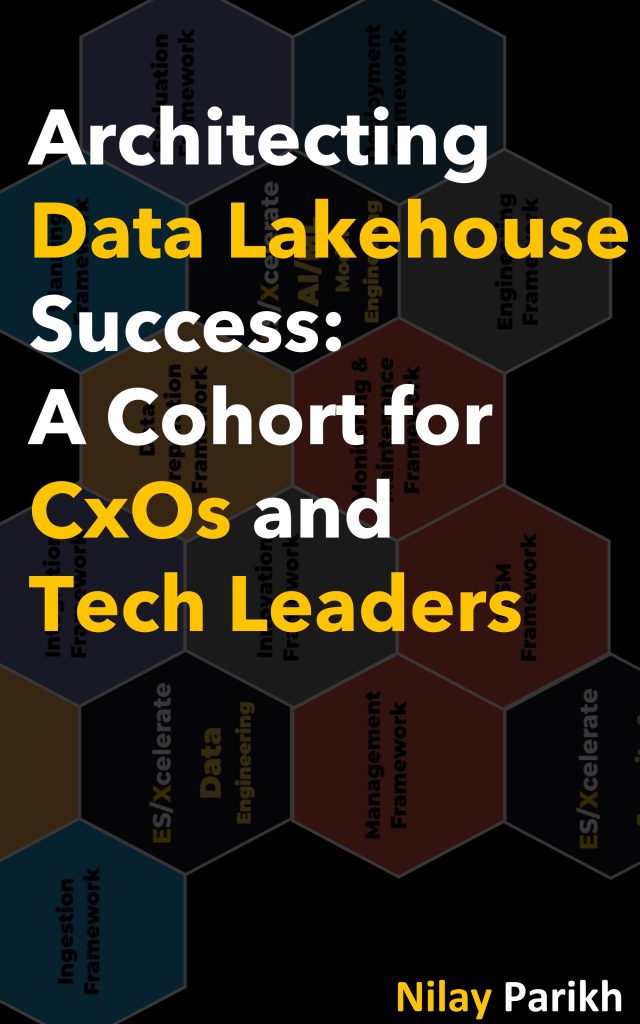
In “Architecting Data Lakehouse Success: A Cohort for CxOs and Tech Leaders,” we embark on an insightful journey through the evolving landscape of data engineering and architecture. This book is a comprehensive exploration, spanning the history, anatomy, and practical application of data lakehouses. It’s designed for technical leaders, architects, and C-suite executives who aim to merge strategic business vision with technical architectural prowess.
Ensuring robust security and data governance should be a critical priority across technical and leadership teams. For architects, emphasis must be placed on implementing context-aware access controls, state-of-the-art encryption, and real-time data classification leveraging AI. These mechanisms for securing sensitive data and monitoring usage form the foundation of a compliant data lakehouse. Furthermore, advancing data lineage tools to support rapid impact analysis and granular policy enforcement enables governance at scale.
Meanwhile, the perspectives of product owners, managers, and CXOs are crucial for aligning these governance capabilities with strategic business objectives. A clear roadmap for progressively maturing data protection in lockstep with emerging regulatory requirements would maximize risk mitigation while delivering stakeholder confidence. Moreover, framing governance as an investment which pays dividends – not just a compliance cost – fosters buy-in. Overall by tackling capability upgrades through cross-functional collaboration, robust data management unlocks innovation rather than stifles it. With advanced data governance, secured systems become trusted systems, driving competitive advantage.
Architectural Principles for Solution & Technical Architects and Enterprise Architects
| Principle | Description | Exceptions |
|---|---|---|
| API Security | Ensure APIs interacting with the data lakehouse are secure and comply with industry standards. | Legacy systems where API modernization is not feasible in the short term. |
| Encryption by Default | All data, at rest and in transit, should be encrypted. | Situations where encryption may impede necessary data processing speeds. |
| Data Lifecycle Management | Implement policies for data retention, archiving, and purging in compliance with legal and business requirements. | Exceptions may arise due to differing regulatory requirements in various jurisdictions. |
| Zero Trust Operations | Operate on a zero-trust model, verifying every access request irrespective of the location. | Restricted environments where trust levels are predefined and unchangeable. |
| Advanced Threat Detection | Use AI and ML for proactive threat detection and response in the data lakehouse. | Environments where AI/ML solutions are not implementable due to technical or cost constraints. |
| Continuous Compliance Monitoring | Regularly monitor and audit systems to ensure ongoing compliance with regulations. | Small-scale or low-risk projects where extensive monitoring is not cost-effective. |
| Data Sovereignty Compliance | Adhere to data sovereignty laws for data storage and processing. | Instances where data sovereignty is not applicable due to the nature or location of the data. |
Learn from My Mistakes, Perspectives of Edward de Bono’s Six Thinking Hats:
Red Hat (Emotions): With rising cyber threats and changing regulations, there is anxiety amongst leadership about properly securing sensitive data in our lakehouse and avoiding substantial breach fines or lawsuits. However, investing in upgraded governance solutions would provide confidence.
Black Hat (Critical Judgment): We have vulnerable legacy systems interconnected with our advanced data analytics platforms. Failure to upgrade these outdated technologies substantially raises the risk of noncompliance with evolving regulations.
Green Hat (Creativity): What innovative policy enforcement mechanisms can we build by integrating blockchain-based decentralized identity management with our analytical workflows? Can we use AI to partially automate compliance audits?1
Risk Areas and Mitigation Strategies
| Risk | Mitigation |
|---|---|
| Unauthorized Data Access | Implement robust multi-factor authentication, attribute-based access control, and role-based access policies. |
| Data Breach or Leakage | Utilize advanced encryption for data in transit and at rest, and adopt comprehensive network security measures including firewalls and intrusion detection systems. |
| Non-Compliance with Regulations | Conduct regular audits, implement continuous compliance monitoring systems, and integrate AI-driven tools for real-time compliance tracking. |
| Inadequate Data Governance | Establish strong data lineage practices, including automated capture and integration with data catalogs for transparency and auditability. |
| Insufficient Network Security | Implement layered security approaches, including perimeter defense and internal segmentation, and enforce strict network access control lists. |
| Compromised Credentials | Use multi-factor authentication and context-aware access controls to minimize risks of compromised credentials. |
| Inefficient Incident Response | Develop and regularly update an incident response plan, and train staff in rapid and effective incident management. |
| AI Model Bias or Unethical Use | Develop ethical AI frameworks and ensure AI models comply with regulations like the EU AI Law, focusing on fairness and non-discrimination. |
| Third-Party Risk Management | Conduct thorough risk assessments for vendors and include AI compliance clauses in contracts, especially for GDPR and SOX compliance. |
| Data Integrity Challenges | Implement robust data lifecycle management policies and ensure data quality through governance policies like data quality rules and privacy constraints. |
| Inadequate Staff Awareness | Conduct regular training sessions on the latest security threats, best practices, and conduct phishing simulation exercises. |
| Complex System Integration | Standardize data processing practices and adopt scalable tools to manage complexity in large-scale systems. |
| Real-time Data Processing Delays | Ensure that data lineage tools can handle high-velocity data without compromising accuracy in real-time processing systems. |
| Incomplete or Inaccurate Data Lineage | Utilize interactive lineage graphs and maintain version history of data transformations for accurate lineage tracking. |
| Malicious Insider Activities | Proactively monitor access patterns and user activities to identify and mitigate insider threats. |
- The information provided is a matter of personal opinion rather than a result of personal experience. ↩︎
Available at Amazon
- US: https://www.amazon.com/dp/B0CR71D58S
- UK: https://www.amazon.co.uk/dp/B0CR71D58S
- IN: https://www.amazon.in/dp/B0CR71D58S
- DE: https://www.amazon.de/dp/B0CR71D58S
- FR: https://www.amazon.fr/dp/B0CR71D58S
- ES: https://www.amazon.es/dp/B0CR71D58S
- IT: https://www.amazon.it/dp/B0CR71D58S
- NL: https://www.amazon.nl/dp/B0CR71D58S
- JP: https://www.amazon.co.jp/dp/B0CR71D58S
- BR: https://www.amazon.com.br/dp/B0CR71D58S
- CA: https://www.amazon.ca/dp/B0CR71D58S
- MX: https://www.amazon.com.mx/dp/B0CR71D58S
- AU: https://www.amazon.com.au/dp/B0CR71D58S
Disclaimer
The views expressed on this site are personal opinions only and have no affiliation. See full disclaimer, terms & conditions, and privacy policy. No obligations assumed.
